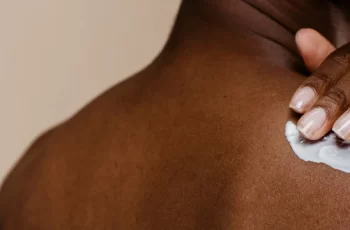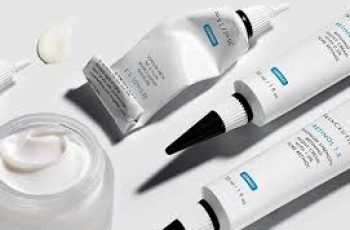
What to Do about Pesky Retinol Peeling
If you have ever used retinoids like tretinoin, adapalene, or tazarotene for their amazing anti-aging or acne-fighting benefits, you are probably familiar with one of their most notable side effects: skin peeling. Sometimes referred to as the “retinol uglies,” this skin flaking can be unsightly and is often made worse when you apply makeup or concealer on top of it. Retinol peeling is also often worse around the eyes and can make the delicate skin in this area look dull or tired.
Fortunately, there are some things you can do to fix and even minimize retinol peeling. Here, I discuss why your face gets flaky when using retinoids and what you can do about it.
Retinol peeling is normal and usually happens for the first several weeks after starting a new retinol regimen.
Gentle exfoliation, mixing an HA serum with your makeup, and using a barrier repair moisturizing cream can help with retinol peeling.
Gradually increase the strength and frequency with which you apply retinoids to minimize retinol peeling and dryness.
Why Does Retinol Peeling Happen?
Retinoids speed up skin cell turnover by increasing the rate of desquamation, which is the exfoliation process that your skin naturally undergoes to shed dead skin cells from the surface. Retinoids achieve this by boosting the activity of a growth factor called epidermal growth factor (EGF), which causes the outer layer of skin cells, called keratinocytes, to multiply and differentiate faster than usual (3, 4).
Research shows that retinoids enhance the number of EGF receptors, which in turn speeds up skin regeneration and repair. While this process is excellent for treating acne, hyperpigmentation, and signs of aging, this rapid cell turnover often leads to the retinol peeling you see as dead skin cells shed at a faster rate than your skin is used to (5).
Increased epidermal growth factor also causes your skin’s outer layer to thicken (a process known as hyperplasia), which is actually a good thing, as it strengthens the skin barrier over time. However, during the initial phase of introducing a retinoid into your skin care regimen, this cell renewal process can cause peeling, dryness, and irritation as your skin adjusts.
How to Fix Retinol Peeling
While retinoids do commonly cause flaking and dryness for the first several weeks of use, you can help to minimize retinol peeling with these tips.
Gentle Exfoliation
Retinoids are already an exfoliant, so you do need to be careful not to over-exfoliate your skin while using them, which can make retinol peeling worse. However, you can use a gentle facial scrub when you need to get rid of the flakes for an important event or other instance when you want your skin to look its best. At other times, just let the desquamation happen on its own. Over time, the amount of retinol peeling you see should decrease.
Use gentle exfoliation about every three days and time it for when you need to wear makeup. Otherwise, makeup can become trapped in the crevices between flaking skin cells and accentuate their appearance.
Mix a Hyaluronic Acid (HA) Serum with Makeup
When you do need to wear makeup while introducing your skin to a retinoid, adding an HA serum to your makeup or concealer can help to smooth the skin and minimize the appearance of retinol peeling. My favorite serum for this purpose is the Alastin HA Immerse Serum.
You can also mix your regular moisturizer with makeup, but I find that the Alastin HA serum works best for retinol peeling, and I have tried many of them!
Use a Soothing Barrier Repair Moisturizer
Regularly applying a barrier repair moisturizer while using retinoids is essential to minimize flaking, dryness, and irritation. Barrier repair moisturizers help to keep moisture sealed inside your skin, while also keeping irritants out.
Some of my favorite barrier repair moisturizers to use with retinoids include:
How Long Does Retinol Peeling Last?
Generally speaking, retinol peeling can last around four weeks. However, the exact duration of the “retinol uglies” will vary from person to person and will depend on a number of factors, such as your skin type, how often you are using the retinoid, and the strength of the active ingredient. While many people are tempted to stop using retinoids when their skin begins to peel or becomes dry, do not give up! As your skin adjusts to retinol, flaking and dryness should subside and you will start seeing smoother, clearer, and more even-toned skin.
Can You Prevent Retinol Peeling?
While it is difficult to prevent all retinol peeling, especially when first starting a retinoid, there are some things you can do to minimize this common side effect. Most importantly, make sure you gradually introduce your skin to a retinoid. You can also talk to your dermatologist about starting with a lower strength retinoid if you have never used these ingredients before. You can then gradually work your way up to a stronger product to help minimize retinol peeling.
Additionally, know which ingredients don’t mix well with retinoids to help reduce retinol peeling. Do not use more than a gentle exfoliating scrub while using retinoids, as too much exfoliation will make flaking and peeling worse. If you are just starting a retinoid regimen, avoid products that contain acids like glycolic acid or salicylic acid, as these can make flaking and dryness worse. Of course, your skin care regimen should be tailored to your Baumann Skin Type so you do not make problems like dryness, redness, or irritation worse by using the wrong products for your skin.
Bottom Line
Retinoids like retinol, tretinoin, adapalene, and tazarotene are some of the best anti-aging ingredients out there. While the flaking they can cause – sometimes called retinol peeling or “retinol uglies” – makes many people afraid to use them, following the tips in this guide can help you reap the many benefits of retinoids while minimizing their side effects.


